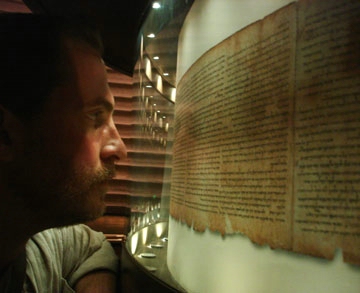Religious texts dated between 150 BC and 70 AD and written in Hebrew, Aramaic and Greek on parchment or papyrus, the scrolls include the oldest-known surviving copies of the Bible as well as religious commentary that followed the return from the exile in Babylon. As the on-air investigator for “Writing the Dead Sea Scrolls,” which aired Tuesday, July 27th on the National Geographic Channel, Cargill talked to nine archaeologists and other scholars who are conducting research that is challenging old assumptions about the authorship of the texts.
Cargill is known for his work on a three-dimensional computer model of Qumran, a first-century settlement on the shores of the Dead Sea. The Dead Sea Scrolls were discovered in 11 nearby caves at various times between 1947 and 1956. In his 2009 book, “Qumran through (Real) Time,” Cargill argued that at least some of the more than 800 scrolls now known to exist were produced at Qumran.

Archaeologist Robert Cargill examines a full-scale facsimile of the 2000-year-old-plus Isaiah Scroll at Jerusalem's Shrine of the Book. Credit: UCLA
“I’ve spent my career reading the work of major scholars involved in the archaeology of Qumran,” said Cargill. “Actually meeting many of them opened up a whole new depth of understanding for me.
As part of a National Geographic documentary, Cargill visited Qumran and its nearby caves. He also traveled to other first-century settlements on the Dead Sea, including Masada, a mountaintop fortress where similar scrolls were discovered. He also visits an ancient sewer system beneath Jerusalem that may have been used to smuggle scrolls and other possessions out of the city during the first-century Jewish Revolt.
The authorship of the scrolls has been the subject of intense debate since their discovery. They have long been thought to be the handiwork of the Essenes, an obscure breakaway Jewish sect that may have occupied Qumran during the first century A.D. But another hypothesis says different Jewish sects may also have had a hand in producing scrolls. With the destruction of the Second Temple by Roman soldiers in 70 A.D., the sects may have spirited the scrolls through the sewers to the caves around Qumran, tipping the Essenes off to the need to hide their own scrolls there as well.
"I don't buy it," said Lawrence Schiffman, a professor of Hebrew and Judaic Studies at New York University (NYU), who added that the idea of the scrolls being written by multiple Jewish groups from Jerusalem has been around since the 1950s. "The Jerusalem theory has been rejected by virtually everyone in the field. The notion that someone brought a bunch of scrolls together from some other location and deposited them in a cave is very, very unlikely."
Regarding the Isaiah Scroll, Cargills says. "Nobody I know has ever been down there. As a scholar, it’s as close as you can get to a religious experience.”
Source: Meg Sullivan, UCLA - Scholar highlights new research on Dead Sea Scrolls in TV special






Comments